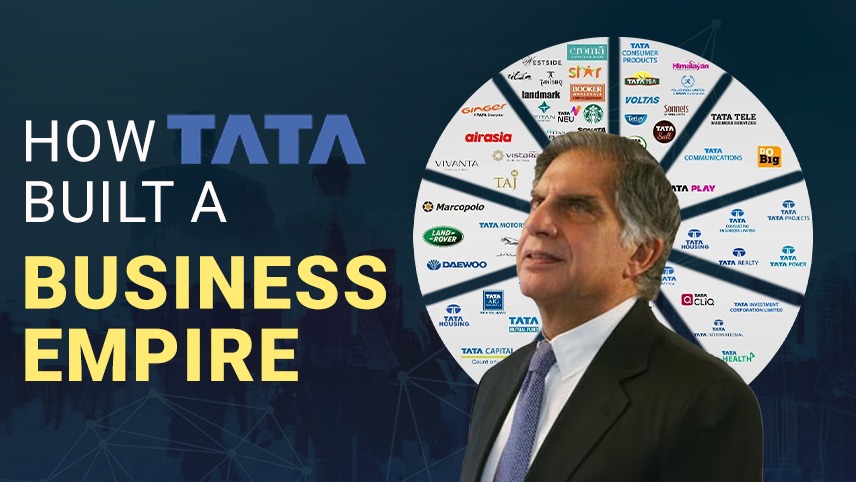
The Tata Legacy: How India’s Most Trusted Business Empire Was Built
In a country as diverse and dynamic as India, trust is not easily earned. Especially in business. Yet, one name has stood tall for over 150 years, Tata. Whether it's salt or software, cars or consulting, steel or satellites, the Tata Group has touched nearly every aspect of Indian life. But this isn’t just about building a business, it’s about creating a legacy. It’s the story of a vision that began long before independence. A vision that continues to shape the present and quietly prepare India for the future.
What makes Tata so special? How did it grow from a humble textile business into a global empire? And why do millions of Indians still see the Tata name as a mark of honesty, reliability, and progress?
To answer these questions, we have to go back to where it all began. Not in a boardroom. But in the heart of a dreamer.
It All Began with a Dream
More than 150 years ago, in a small town called Navsari in Gujarat, a boy named Jamsetji Tata was born into a world where India was under British rule, and Indian entrepreneurs were barely given a chance to rise. He was born into a family of Parsi priests, but Jamsetji had a different calling. He saw business not just as a way to earn profit but as a means to build a nation. That belief, held deeply in his heart and became the seed of what we now know as the Tata Group, India’s most respected business empire.
What makes this legacy special isn't just its size or wealth. It’s the intention behind it. Jamsetji didn't want to build just a business; he wanted to build India.
A Vision Larger Than Business
When Jamsetji Tata entered the textile business in the late 1800s, he wasn’t the only player. But he was different. Where others treated employees like machines, he valued them as human beings. At a time when laborers were exploited, he introduced pensions, medical care, and better working conditions. In the British era, this wasn’t just rare, it was almost rebellious.
He built Empress Mills in Nagpur, not in Bombay (now Mumbai), because he wanted to generate employment in the interior parts of India. He took cotton mill design inspiration from Manchester but tailored it to Indian needs. From the very beginning, Tata’s business decisions weren’t just about profit, they were about purpose.
And here lies the first lesson for any Indian entrepreneur reading this, success built on empathy creates empires that last.
The Foundations of an Empire
While Jamsetji’s textile business did well, his heart was set on bigger things, three dreams that seemed impossible back then: an iron and steel company, a hydroelectric power plant, and a world-class educational institution.
People laughed. British officials ridiculed him. But he kept going.
Sadly, Jamsetji passed away in 1904, before any of these dreams became reality. But his legacy was too powerful to die. His sons and successors carried it forward. And this is where the Tata name began turning into something more than just a brand, it became a belief.
In 1907, Tata Steel didn’t just make history as India’s first steel company — it became Asia’s first fully integrated steel plant, setting the foundation for industrial growth across the continent. And when the Tata Institute of Science (now IISc, Bangalore) was set up, it was the first serious attempt to build scientific talent in India. These weren’t just corporate achievements. These were acts of nation-building.
The Untold Struggles Behind the Success
It’s easy to admire the Tata Group today, an empire built on trust, values, and vision. But behind the achievements were battles. Some visible, many quiet. And it's in these struggles that the real Tata story comes alive.
When Jamsetji Tata dared to build a steel plant in British-ruled India, he wasn’t just up against market risks. He stood up against a colonial system that held back Indian businesses from growing. British officers mocked his ambition. They believed Indians could never produce steel of global quality. Loans were hard to get. Expertise had to be imported. Yet, he pushed on. It wasn’t easy, and he didn’t even live to see it happen.
That’s when Tata Steel took its first bold steps forward—driven by the vision and leadership of Dorabji Tata, Jamshedji’s son. The world plunged into World War I, and steel demand spiked, but so did operational pressures. Raw material shortages, inflation, and rising debts tested their limits. But they held on. The war ended, and Tata Steel survived, not because of luck, but because of courage and resilience.
Years later, JRD Tata took over in a world that was recovering from the Great Depression. He faced the enormous task of modernizing the Tata companies without losing their ethical compass. The pressure to cut corners and chase profits was real, but JRD refused. He introduced labor rights, fair wages, and long-term employee welfare when most businesses were only thinking short-term.
Even the boldest Tata ventures weren’t immune to failure. The Tata Nano stands out as one of the most heartbreaking business lessons in India’s automotive history. It was born from a beautiful idea, giving Indian families a safe, affordable car. But the execution met with unforeseen hurdles. The land acquisition issues in Singur led to massive delays. Political backlash, logistical chaos, and public perception issues hurt the project. Sales never took off as expected. The dream struggled, and eventually, the Nano faded.
But what stood out wasn’t the failure, it was how Tata handled it. With grace. With dignity. No finger-pointing. No media blames games. They accepted the outcome and moved forward. That’s real leadership.
Under Ratan Tata’s leadership, one of the boldest tests came in the form of global acquisitions, a move that would redefine the Tata Group’s international identity. Buying Jaguar-Land Rover was a proud moment, but right after that, the 2008 global financial crisis hit. Tata had spent billions, and now the luxury car market was crashing. Experts said it would sink them. But they stayed calm, focused, and resilient. Within a few years, JLR was profitable again.
Even today, the group faces its share of tests. The digital era brings competition from startups and tech giants. Managing such a vast conglomerate while keeping its core values intact isn’t easy. But with N. Chandrasekaran at the helm, the group is adapting, entering AI, EVs, space tech, and even semiconductors.
So, what does this mean for you as an entrepreneur?
That no matter how iconic your vision, you will face storms. Delays will happen. People will doubt you. The market may shift under your feet. But if your foundation is strong, built on values, built on purpose, you will survive. And not just survive, you will grow.
A Family That Built for the Nation
Many business empires are built around dynasties. The Tata family didn’t chase quick profits, they followed a purpose-driven path few dared to take. The Tatas never tried to put their personal wealth above the country. They didn’t flaunt lavish lifestyles or build businesses only for self-gain. Instead, they gave most of it back.
Do you know that over 66% of the shares of Tata Sons, the holding company of the Tata Group, are held by philanthropic trusts? These trusts support education, health, rural development, and arts. That means the profits earned by Tata businesses flow back into society.
For today’s business owners, this approach teaches something powerful: true business growth happens when your business gives more than it takes.
Rise of JRD Tata – The Sky Was No Longer the Limit
When JRD Tata took the reins, the company entered a new age. He wasn’t just a businessman, he was a pioneer. Back in 1932, he launched Tata Airlines, the first step toward what we now know as Air India. At a time when flying was considered a luxury only for the West, he imagined a future where Indians could fly across the country.
JRD also had a passion for innovation. With his visionary leadership, iconic brands like Tata Motors, TCS, and Tata Chemicals came to life, shaping the future of Indian industry. He was known for pushing boundaries, not just in products, but in thinking.
And perhaps what made JRD truly remarkable was that he brought corporate professionalism to Indian business. He believed that ethics were not optional. He believed in dignity at the workplace. And more importantly, he led by example.
Ratan Tata: The Silent Visionary Who Changed the Game
When Ratan Tata took over in the early 1990s, India was a different place. Liberalization had just begun, and global competition was entering fast. Many thought the Tata Group, with its old-school values, wouldn't survive.
But Ratan Tata had other plans.
He consolidated the group, took bold decisions, and entered new sectors. It was under his leadership that Tata made its most iconic global moves, the acquisition of Tetley Tea, Corus Steel, and Jaguar-Land Rover.
Think about it, an Indian company, once mocked during colonial times, was now buying out British icons. That wasn’t just business, it was poetic justice.
And yet, Ratan Tata remained grounded. He didn’t chase headlines or personal fame. He focused on something else: dignity, trust, and purpose-driven growth.
The Nano: A Story of Heart, Not Just Horsepower
Perhaps the most emotional chapter in the Tata story is the birth of the Tata Nano, a car built with the dream of making transportation affordable for Indian families. It wasn't about profit margins; it was about dreams on wheels.
While the Nano didn’t succeed commercially, its message touched millions. It reminded us that real innovation isn’t always measured in sales. Success often starts with knowing exactly who you're creating value for.
In business, not every idea becomes a success. But the courage to dream, and the intent behind that dream, often matters more than the outcome.
A Brand Built on Trust
Today, when Indians hear the word Tata, they don’t just think of a product, they think of trust. Whether it’s salt in the kitchen, a mobile network, a luxury car, or an IT service, the Tata name carries a promise.
And that trust wasn’t built through advertising. It was built over generations, by consistently doing the right thing, even when it was the harder choice.
There’s a business insight hiding here, your brand is not what you say, it’s what you repeatedly do.
What Entrepreneurs Can Learn from the Tata Journey
The Tata legacy isn’t just a story for history books. It’s a living lesson in how to build a business with heart, scale with purpose, and grow without losing your soul.
It teaches us that:
Profit and purpose can go hand-in-hand.
Legacy is more powerful than legacy wealth.
Giving back is not charity, it’s good business.
Ethical business is not just possible in India, it’s powerful.
National pride and business growth can grow together.
These are not outdated values. In a noisy, fast-paced, digital-first world, they matter more than ever. Because consumers today are not just buying products, they’re buying trust.
Final Takeaway: Create a Legacy That Outlives Your Business
If you’re an entrepreneur reading this today, you don’t need to start with crores in funding. You don’t need foreign investors or a high-end office to build something powerful.
What you need is clarity of purpose, consistency in action, and a deep sense of responsibility toward society.
The journey of Tata shows that in a world chasing shortcuts, it’s steady values and long-term vision that create lasting business legacies. And legacies don’t just make you successful, they make you unforgettable.
So the question is not “Can you be the next Tata?”
Are you creating something today that people will still care about a hundred years from now?
That’s the real measure of greatness.
- Businessman
- BusinessGrowth
- Market Analysis
- Business case study






